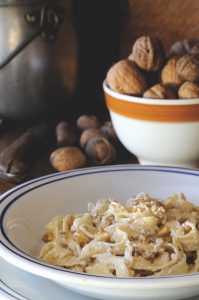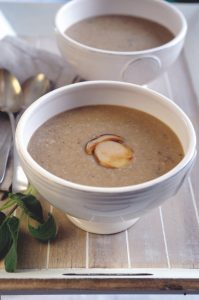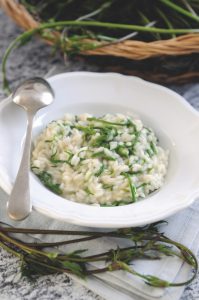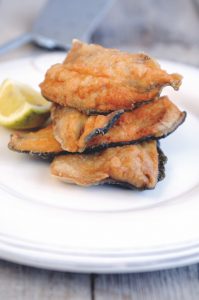Mario Matassa celebrates the start of the autumn foraging season with a set of Italian recipes that all contain ingredients that can be gathered for free
Photos by Mario Matassa
Italians are simply wild about wild food. Whether it’s chestnuts, borage leaves and mushrooms in the autumn, truffles in the winter, asparagus, wild hops, nettles and dandelions in the spring, or wild garlic, berries and fruits in the summer, there’s always something that has Italians taking to the forests, mountains, countryside and even their gardens with their baskets at their side.

Wild foods in Italy are not niche. Most Italians will regularly eat something they’ve collected themselves. To get a clear idea of what we are talking about, at one end of the spectrum is hunting. Italians are passionate hunters and game such as hare, wild rabbit, venison and wild boar is highly prized. However, not everyone in Italy hunts, and not everyone will go to the trouble of obtaining a licence to go hunting. Italians are also avid fishers. With 7,500km of coastline that probably won’t come as much of a surprise. But let’s not forget the streams and rivers that flow down both sides of the Apennines and through the Alps. Freshwater fish is very popular in Italy and the range will probably surprise you – Lake Garda alone has 30 types!
More popular, and more accessible, are the various foraged foods which are available to everyone, if you have a little knowledge and are prepared to put in a bit of effort. Foragers are not difficult to spot. They’re the ones invariably with a walking stick in one hand and a basket in the other. Sometimes they’re wearing a pair of Wellington boots, depending on the season.
The Italians’ passion for foraged foods stems in part, no doubt, from the fact that most Italians will have been introduced to the art of foraging at a very early age. Young children walking with their parents and grandparents along a country road covered in dark reddish-black stains have invariably been picking berries! In Italy, it is still considered something of a family day out to go berry picking – if you take into consideration the following day spent making jam, it’s a whole weekend’s entertainment.
The repertoire of recipes for foraged foods is as long as that for conventional foods. Where foraged foods differ is that the window of opportunity is often short. Chestnuts start falling from the trees in late September/early October, depending on the conditions. By the end of October the season is effectively finished. Fresh green walnuts have to be collected at the end of June if you want to make a few bottles of liqueur, and elderflowers are in blossom for just a few weeks in late spring if you fancy making fritters. However, if you don’t, not all is lost. The same tree bears its fruit in late July if you want to make jam.
 Chestnuts
Chestnuts
The chestnut, la castagna, is the fruit of the sweet chestnut tree. The fruit falls from the tree from late September until the end of October. There are many different varieties of chestnut, but they are generally divided into two camps – castagna and marrone. The latter is distinguished by its larger size. Chestnuts were for a long time an essential staple in Italy’s mountainous regions, the fruit being used in lieu of more conventional staples to make flour and polenta, the cucina povera of the local people. Nowadays chestnuts are used in both savoury and sweet dishes throughout Italy. They can be bought dried, frozen or in tins, but are almost certainly best when picked fresh from the forest floor. The only difficulty with them is when it comes to peeling, which requires more than a modicum of patience. But do persevere, because it’s worth the effort!
This soup (left) is a great way to use chestnuts in your cooking
Walnuts
The walnut (noce) is a highly nutritious nut that is rich in omega-3, making it a good alternative for people who don’t eat fish. It will grow happily in England, but is surprisingly rare. There are several different kinds of walnut grown in Italy, but the large noce di Sorrento from Campania is considered by many to be the best. At the start of the summer, Italians collect fresh green walnuts to make a liqueur known as nocino. As walnut tress grow throughout Italy, this has become a popular after-dinner tipple throughout the country. The nuts that remain are left to mature on the tree into the late autumn, when they are harvested and used in both sweet and savoury dishes. The recipe below is a popular early winter dish that can be found in many restaurants.
Here’s Mario’s walnut recipe to try
 Wild hops, nettles and asparagus
Wild hops, nettles and asparagus
It’s a sure sign that spring is in the air when you start seeing Italians stooped over by the roadside collecting nettles, hops and wild asparagus. It’s in the early spring when the shoots and leaves are at their most tender and their emergence sets off a frenzy of springtime dishes, from asparagus frittata to ravioli stuffed with cheese and nettles, to wild hop risotto. All three ingredients have health benefits (digestive, tonic and diuretic), they are packed with vitamins, and they are highly flavoursome. The dish below is a great way to use wild hops, but it can also be made with any of the above three ingredients, or a combination.
Make a risotto with wild hops (pictured right) – here’s how…
Wild greens
Wild greens – verdure selvatiche is the general name given to greens that grow naturally in the wild – are as popular as ever in Italy. In the autumn, in the Lunigiana region of Tuscany, they make a wild green pie from 14 different varieties of wild greens, including borage leaves, nettles and dandelions. Similar pies are made across the country by women who hold the family secret recipe. The tradition is handed down and every family has its own stash of recipes for wild greens. Indeed, for every region, province, even comune, in Italy there is sure to be at least one recipe for pasta stuffed or dressed with wild greens. Among the most commonly collected are borage, wild fennel, hops, rocket, garlic leaves, wild beets, wild chicory, nettles, dandelions, asparagus and, of course, erbe aromatiche, wild herbs.
Try this recipe for foraged wild greens
 Freshwater fish
Freshwater fish
Freshwater fish, pesci d’acqua dolce, are found in Italy’s lakes (natural and man-made), and the countless streams that run down either side of the Apennine mountains and the Alps. Among the most popular are trout, carp, eels, sturgeon, pike, catfish, pollan and perch. The demand for wild freshwater fish was such that at one point stocks were running low. However, recent efforts to repopulate the rivers and lakes, often instigated by local fishing societies themselves, have been highly successful and today stocks remain stable.
Cooking wild freshwater fish is considered something of an occasion in Italy. In the recipe below, which was adapted from a method for cooking trout in the Apennine mountains above Parma, the trout is coated in flour and chilli pepper, then pan-fried until crisp. In my recipe I used wild trout but with the addition of more chilli pepper, farmed trout also works well.
Try Mario’s trout recipe (pictured above) here
Mushrooms
If you were to single out one thing when it comes to wild food, it’s the Italian love for mushrooms (funghi). Porcini reign supreme, but there are literally dozens of edible varieties on offer over the course of the year. The St George’s Day mushroom is generally considered the first to make an appearance, which is excellent cooked with garlic and parsley, then served over crusty bread. However, they should only be eaten in moderate quantities as they can be difficult to digest. Among the most popular types of mushroom are field mushrooms, oyster mushrooms, chiodini and cantarelli.
Die-hard mushroom pickers in Italy will sacrifice whole weekends in pursuit of the perfect mushroom. However, it’s a pursuit which is fraught with risk. Some of Italy’s most prized mushrooms are very similar to inedible varieties, some of which are deadly poisonous. Every year many inexperienced pickers are rushed to casualty, so if you have a hankering for fresh mushrooms it’s wise to take along someone who knows exactly what to look for.
Mario’s mushroom pasta recipe can be found here
